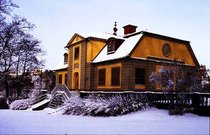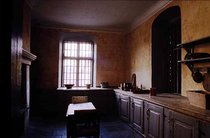Svindersvik
Squeezed between the busy trunk road Värmdöleden and the skyscrapers of Nacka stands a small manor house from the 18th century, surrounded by an abundant garden. This is Svindersvik, one of the best preserved rococo establishments in Sweden.
Svindersvik is named after a Dutchman, Johan van Swindern, who was granted a royal licence to manufacture pitch here. Svindersvik was purchased in 1721 by banker and squire Claes Grill. He built the main building in the 1740s, together with a kitchen wing, a pavilion with a large assembly hall, and some small red houses for servants, horses and carriages, all in the rococo style of the time. The main building is of brick, with yellow plaster facade, and stands two storeys high with a metal-sheathed hipped roof. This building was designed by Carl Hårleman, who gave the house a structure according to the French style that was then popular. In the rooms stand tiled stoves and silk-clad furniture from the 18th century. The walls are covered with Chinese rice paper with floral designs from the orient.
An original 18th century kitchen
Most of the furniture is from the end of the 18th century, and most of the equipment in the kitchen is from the same period.
The pavilion houses a magnificent assembly hall with decorated walls and what is probably the tallest tiled stove in Sweden, and a suite of guest rooms with beautiful furniture.
Svindersvik had several owners during the 19th century, of whom KA Almgren, who produced silk, is the most well known. The Almgren family was the last private owner.
Svindersvik was donated to Nordiska Museet in the 1940s, and this is one of the reasons that it is so well preserved and has retained its idyllic atmosphere. Another reason is that it never was used for year-round accommodation.
The French garden
It is not just indoors that the French influence is seen. The garden at Svindersvik was built following the 18th century principles of symmetry, and is divided into four parts. The trunks of the oldest apple trees are today as hollow as chimneys, but even so, the trees bear fruit every year.
Despite its modern surroundings, the buildings and the park convey an experience of the 18th century to visitors.
Links
Closest public transport is the SL stop at Nacka station (Saltsjöbanan).


